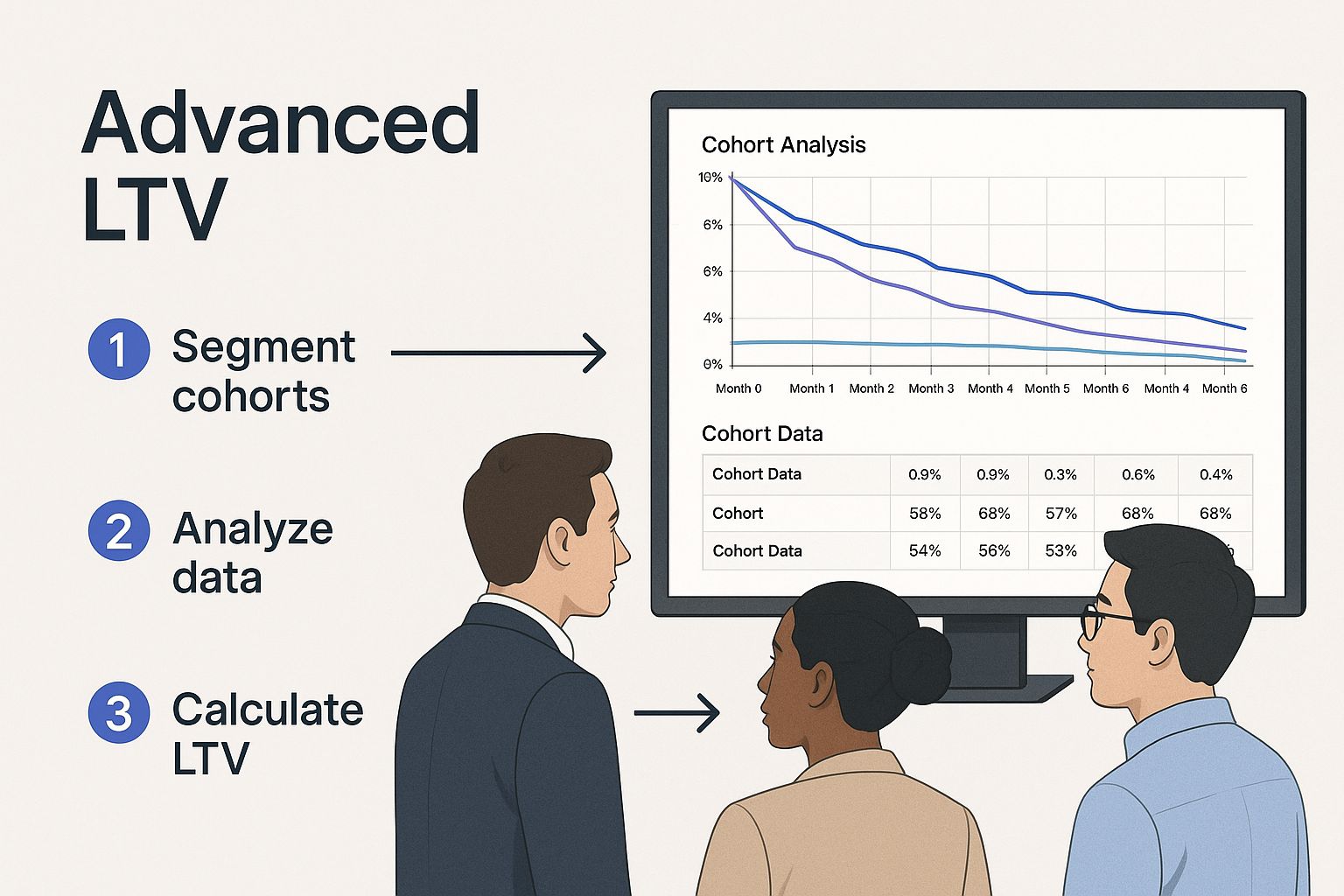A Guide to Calculate LTV SaaS for Growth
Learn how to calculate LTV SaaS with practical formulas and real-world examples. Understand this key metric to drive sustainable growth for your business.

To get a handle on SaaS LTV, think of it as the total money a customer will likely spend with you over their time as a subscriber. It’s a health check for your business and tells you what each new customer is worth in the long run.
Why LTV Is a Game-Changer for Your SaaS Business
Lifetime Value (LTV) is a core metric that should shape everything from your marketing budget to your product roadmap. A high LTV is a great sign. It means your customers are happy, they’re getting real value from your product, and they’re sticking around.
Basically, LTV makes you look beyond short-term wins like monthly recurring revenue (MRR) and focus on sustainable, long-term growth. It helps you answer the tough questions every SaaS founder and leader wrestles with.
The Building Blocks of an Accurate LTV Calculation
Before you crunch the numbers, you need to pull together a few key pieces of data. Each one gives you a different part of the customer story and is needed for getting an LTV figure you can trust.
To get started, you'll need to gather the core metrics that feed into the LTV formula. This table breaks down what you need and why it matters.
Having these numbers on hand will make the calculation process much smoother and give you a final LTV figure that is grounded in reality.

Making Smarter Decisions with LTV
Once you know your LTV, you can start making more informed decisions across the business. For example, knowing a customer's potential value helps you figure out a reasonable budget for acquiring them. This is your Customer Acquisition Cost (CAC).
A healthy SaaS business model typically aims for an LTV that is at least three times its CAC. This 3:1 ratio is a widely accepted benchmark that signals you’re growing profitably and efficiently.
With a solid LTV number, you can invest confidently in the right marketing channels, prioritize product features that boost retention, and even pinpoint your most valuable customer segments.
For any SaaS company serious about growth, figuring out how to increase customer lifetime value is the logical next step after you've nailed down your baseline calculation. This guide will walk you through the formulas to get that number right.
The Simple Formula to Calculate SaaS LTV
Let's start with the most straightforward way to calculate LTV. This is the method most SaaS companies begin with because it gives you a solid baseline for customer value without getting lost in complex statistical models.
Think of it as the perfect way to get a quick, reliable snapshot of your business's health.
The formula itself is built on three core metrics:
LTV = (ARPA x Gross Margin %) / Customer Churn Rate
Each piece of this formula tells a part of your customer's story. Getting a handle on them individually is the first step to truly knowing the value each customer brings to your business.
Breaking Down the Formula Components
To use the formula correctly, you need to know what each part represents and where to find the numbers.
Average Revenue Per Account (ARPA): This is the average amount of money you make from each customer over a set period, usually a month. To find it, just divide your total Monthly Recurring Revenue (MRR) by your total number of active customers.
Gross Margin %: This shows you how profitable your service is after you account for the direct costs of providing it. These costs, often called Cost of Goods Sold (COGS), include things like hosting fees, third-party software licenses, and salaries for your customer support team. Subtract COGS from your revenue, then divide that number by your total revenue to get your percentage.
Customer Churn Rate: This is the percentage of customers who cancel their subscriptions in a given period. If you start a month with 100 customers and 5 of them leave, your monthly churn rate is 5%. It's a direct reflection of how well you're retaining customers.
A key point here is consistency. If you use your monthly ARPA, you must use your monthly churn rate. Mixing monthly and annual figures is a common mistake that will throw your LTV calculation way off.
A Practical LTV Calculation Example
Alright, let's put these pieces together with a real-world scenario. Imagine you're running a project management SaaS called "TaskFlow."
Here are your monthly numbers:
- ARPA: $60
- Gross Margin: 80% (or 0.80 in the formula)
- Customer Churn Rate: 4% (or 0.04 in the formula)
Now, let's plug these into our formula:
LTV = ($60 x 0.80) / 0.04
First, we figure out the profit you make per customer each month: $60 x 0.80 = $48. This means for every average customer, you're pocketing $48 in profit monthly.
Next, we divide that profit by your churn rate: $48 / 0.04 = $1,200.
Just like that, this simple calculation tells you that the lifetime value of an average TaskFlow customer is $1,200. This number is your baseline. It tells you how much you can reasonably spend to acquire a new customer and still come out ahead in the long run.
This fundamental approach is all about combining these three metrics. For instance, if another business had an ARPU of $50, a gross margin of 70%, and a monthly churn rate of 4%, they would first find their profit per customer ($50 x 0.70 = $35). Then, they'd divide that by the churn rate (0.04) to land on an LTV of $875. You can discover more insights about this formula and its impact on SaaS businesses.
A More Accurate LTV for Complex SaaS Models
The simple LTV formula is a great starting point, but most SaaS businesses aren't that simple. What happens when you're juggling multiple pricing tiers, annual contracts, and a steady stream of upsells? That situation requires a more sophisticated way to calculate LTV, one that gives you a true picture of your business's health.
This is where cohort-based analysis comes in. Instead of lumping all your customers into one giant average, you group them by the month they signed up. This approach lets you track the behavior and revenue of specific customer groups over their entire lifecycle, which is very insightful.
This infographic breaks down how pros use cohort data to get deeper LTV insights.

Analyzing LTV by cohort helps you pinpoint which groups are your most valuable and how changes to your product or pricing affect customer behavior down the road.
Setting Up a Basic Cohort Analysis
The term "cohort analysis" doesn't have to be intimidating. At its heart, you're just tracking groups of customers who joined at the same time and watching how their revenue contribution evolves month after month.
Here's a simplified way to get started:
- Group Customers by Sign-Up Month: Everyone who signed up in January 2024 goes into the "January Cohort." Anyone from February is in the "February Cohort," and so on. Pretty straightforward.
- Track Monthly Revenue: For each cohort, log the total MRR they generate each month after signing up (Month 1, Month 2, Month 3, etc.).
- Calculate Cumulative Revenue: Just add up the revenue from each month to see the total value that cohort has generated over time.
- Find the Average LTV: To get the average LTV for that group, divide the cumulative revenue by the number of customers who were in that cohort to begin with.
Following this process gives you a much richer, more nuanced view than a single, company-wide LTV number ever could. You can start spotting trends, like whether customers from a certain marketing campaign have a higher LTV or if a product update in March led to better long-term value for that month's cohort.
Why Expansion Revenue Changes Everything
One of the biggest weaknesses of the simple LTV formula is that it completely ignores expansion revenue. This is the extra MRR you earn from existing customers who upgrade, buy add-ons, or increase their usage. For any healthy SaaS business, expansion revenue is a massive growth engine.
If you ignore it, you're seriously underestimating your true LTV.
A business with strong expansion MRR can even achieve a negative net churn rate. This is the holy grail for SaaS. It means the new revenue from your existing customers is greater than the revenue you lose from customers who cancel. It's a powerful signal of a sticky product and a very healthy business model.
When you run a cohort analysis, the impact of expansion revenue becomes crystal clear. You'll likely see the MRR from a specific cohort actually increase over time, even as a few customers from that group inevitably churn. This paints a far more optimistic and, more importantly, accurate picture of what a customer is really worth to you.
Of course, the flip side of expansion is churn. If you want to get a better handle on that, check out our guide on churn rate calculation to see how it affects your numbers.
Connecting LTV to Customer Acquisition Cost
Okay, so you've calculated LTV. That's a powerful number, but it only tells you half the story. To figure out if your SaaS business is actually sustainable in the long run, you need to weigh that value against what it costs to get a customer in the door.
This is where the LTV:CAC ratio comes in, and it's a metric every SaaS leader should know well.
This ratio is the bridge between the value a customer brings over their lifetime and the cash you burned to acquire them. A healthy ratio is one of the strongest signals you have of a profitable, scalable business model. If it's too low, you're on a fast track to trouble, spending more to acquire customers than they're actually worth.

Calculating Your Customer Acquisition Cost
Before you can nail down your ratio, you first need to calculate your Customer Acquisition Cost (CAC). The formula itself is pretty straightforward:
CAC = (Total Sales & Marketing Expenses) / (Number of New Customers Acquired)
Your sales and marketing expenses need to include everything you spend to attract new business over a specific period, like a month or a quarter. We're talking about:
- Salaries for your sales and marketing teams.
- Ad spend on platforms like Google or LinkedIn.
- Costs for all your marketing tools and software.
- Commissions and bonuses paid out to your sales reps.
Let's say you spent $50,000 on sales and marketing last quarter and brought in 100 new customers. Your CAC would be $500. Be meticulous here. Leaving out costs will give you an artificially low CAC and a dangerously misleading ratio.
Interpreting the LTV to CAC Ratio
Once you have both LTV and CAC, finding the ratio is simple. An LTV of $1,500 and a CAC of $500 gives you a 3:1 ratio. This is widely considered the gold standard for a healthy SaaS business.
A 3:1 ratio means that for every dollar you spend to acquire a customer, you generate three dollars in lifetime value. It’s a clear sign that your business model is working efficiently.
Of course, benchmarks can vary by industry. For instance, recent data shows Adtech SaaS companies often hit a 7:1 ratio, while Business Services average closer to 3:1. It's worth looking into industry-specific research to see how you stack up.
A ratio dipping below 3:1 is a red flag. It suggests you might be overspending on acquisition or, more likely, you've got a retention problem brewing. This is a good time to sharpen your focus on your customer retention metrics.
On the flip side, a ratio of 5:1 or higher is fantastic. It signals a highly efficient growth engine, and you could probably afford to invest more aggressively in your marketing efforts. To get a holistic view of your SaaS profitability, it's very helpful to use robust business intelligence tools to connect all these dots.
Common Mistakes When Calculating SaaS LTV
Getting your LTV calculation wrong can throw your entire strategy off course. It leads to poor decisions on everything from your marketing budget to your hiring plan. To nail your SaaS LTV, you have to steer clear of a few common pitfalls that can easily skew the numbers.
One of the biggest mistakes I see is failing to segment customers. It's tempting to lump everyone together into a single, neat average, but this is a massive oversimplification. The LTV of an enterprise client is worlds apart from someone on a basic monthly plan. Combining them masks important trends and hides who your most valuable customers really are.
Using Revenue Instead of Gross Margin
Another classic error is calculating LTV with total revenue instead of gross margin. This simple oversight inflates your LTV because it completely ignores the costs of actually serving your customers, like hosting fees, support staff salaries, and third-party software licenses.
Your LTV should always reflect profit, not just revenue. Using gross margin gives you a much more realistic view of how much a customer is actually worth to your business over their lifetime.
This distinction is vital. A high-revenue customer who needs a ton of support might actually be less profitable than a lower-revenue customer who is mostly self-sufficient. Factoring in your Cost of Goods Sold (COGS) grounds your calculations in financial reality.
Underestimating the Calculation Time Frame
Relying on too short of a time frame is another easy way to get misleading results. The average customer lifetime and the horizon you use for revenue projections dramatically shape your LTV.
Most experts recommend forecasting customer revenue and costs for at least three years to get any kind of sustainable insight. This longer view accounts for subscription tenure and captures important trends like churn and expansion revenue. For example, if your typical user stays subscribed for three years with steady monthly fees and predictable churn, the LTV calculation becomes far more accurate and actionable.
Ignoring Indirect Revenue Loss
Beyond basic calculation errors, a lot of SaaS businesses underestimate how external factors can eat away at true customer value. Many don't account for revenue leakage from things like failed payments or chargebacks, which directly reduce the final amount you actually collect from a customer.
For a deeper look into these issues, you can explore the specific challenges of SaaS chargebacks.
Avoiding these common mistakes will help you produce an LTV figure you can actually trust to make strategic decisions. An accurate number is the foundation of any healthy growth model.
Common Questions About SaaS LTV
Once you start looking into LTV, a few questions always pop up. It's totally normal. Getting these sorted out early on will help you avoid common pitfalls and actually use the metric to make smarter decisions. Let's walk through some of the most frequent ones I hear.
How Often Should I Calculate LTV?
A monthly or quarterly cadence is the sweet spot for most SaaS businesses.
Calculating LTV every month is fantastic for keeping a close eye on trends. It lets you react quickly if you see a sudden spike in churn or a drop in average revenue per account.
Quarterly calculations, on the other hand, give you a more stable, big-picture view. They smooth out the noisy month-to-month fluctuations, which is better for strategic planning. If you’ve just launched a major pricing change or a big marketing campaign, you might want to check it more frequently just to see the immediate fallout.
What Is a Good LTV for a SaaS Company?
This is the million-dollar question, but there's no universal "good" LTV number. It varies wildly depending on your industry, who you sell to, and your pricing model. A much more telling metric is your LTV to CAC ratio.
As a rule of thumb, a 3:1 ratio is considered the gold standard. This means for every dollar you spend to get a customer, you're getting three dollars back over their lifetime. If you're hitting 5:1 or higher, you've got an incredibly efficient growth engine.
What really matters is that your LTV is significantly higher than your Customer Acquisition Cost (CAC). If it is, you've got a sustainable business model. Simple as that.
Can I Calculate LTV if My Business Is New?
Absolutely, but you have to be honest with yourself: it’s going to be more of an educated guess at first. With limited historical data, you’re forced to lean on assumptions.
A good starting point is to use industry benchmarks for your key inputs. For example, it's pretty common for early-stage SaaS companies to see annual churn rates between 5% to 7%. You can plug numbers like these in as temporary placeholders.
The key is to not "set it and forget it." As you gather at least 6-12 months of your own customer data, keep revisiting and updating your LTV calculation. It will get sharper and more reliable over time.
How Does Expansion Revenue Affect LTV?
Expansion revenue, which is the extra cash from upgrades, add-ons, and cross-sells, has a massive, positive impact on LTV. It's rocket fuel.
The problem is, the most basic LTV formulas completely ignore it. This leads to a dangerously underestimated view of what your customers are actually worth.
To get a true picture, you need to use a more sophisticated formula that incorporates your net revenue churn rate. This metric cleverly balances the revenue you lose from churned customers against the new revenue you gain from your existing ones.
Factoring in expansion revenue gives you a much more realistic, and often, far more optimistic, view of your customer lifetime value. It shows the true potential of your customers to grow right alongside you.
Ready to turn feedback into growth? Surva.ai gives you the tools to understand your users, reduce churn, and improve retention. Start your journey with us today!


